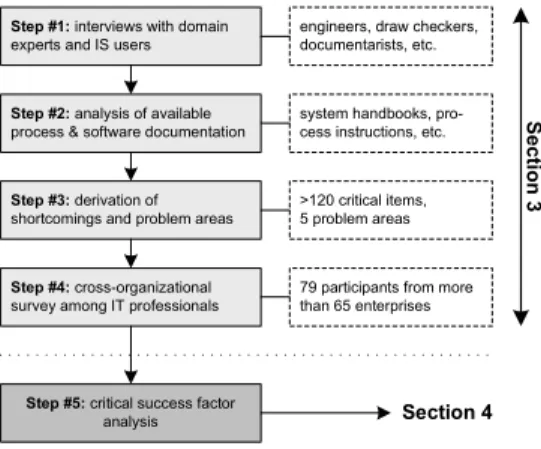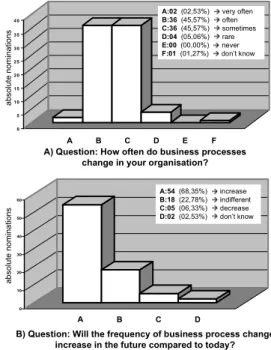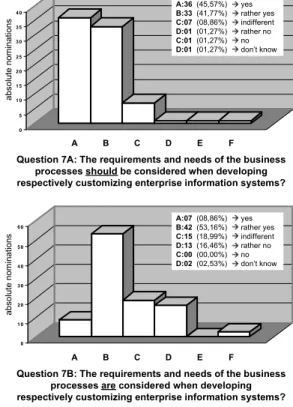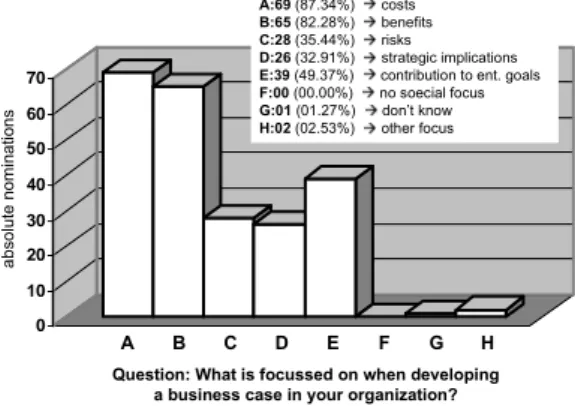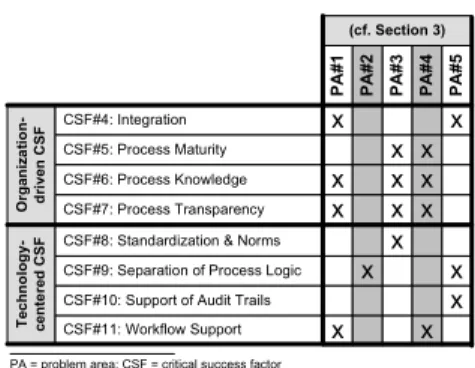Why Process-Orientation is Scarce: An Empirical Study of Process-oriented Information Systems in the Automotive Industry
Bela Mutschler, Johannes Bumiller DaimlerChrysler Research & Technology
P.O. Box 2360, 89013 Ulm, Germany
{bela.mutschler;johannes.bumiller}@daimlerchrysler.com
Manfred Reichert University of Twente Information Systems Group
m.u.reichert@utwente.nl
Abstract
Several studies have indicated that existing IS (IS) often fail to provide adequate business process support. To sys- tematically identify the reasons for this drawback, we con- ducted a case study in the automotive domain and a survey among 79 IT practitioners. This paper presents the findings of this empirical research and explains why mere ”process- orientation” (regarding business process support) is scarce.
1 Motivation
Effectively managing the flow of work within their or- ganization is crucial for enterprises. One critical success factor in this context concerns the alignment of information systems (IS) and business processes [6]. In the automotive domain, for example, a broad spectrum of processes ranging from administrative procedures to knowledge-intense engi- neering processes has to be supported by IS. As a typical ex- ample, consider a product data management (PDM) system, which usually offers a broad range of business functions for the integrated support of engineering processes and product data management.
However, many contemporary enterprise IS fail to pro- vide adequate business process support. The reasons for this drawback are manifold. To systematically identify the reasons for this drawback, we conducted a case study in the automotive domain and a survey among 79 IT practitioners.
In particular, it was our goal to identify shortcomings that derogate the development, maintenance, and use of process- oriented IS in practice. Our empirical research has been guided by four research questions:
• RQ#1: What are major problems leading to inadequate business process support in IS?
• RQ#2: What are the rationales for these problems?
• RQ#3: What are critical success factors which help to overcome the identified problems?
• RQ#4: What is needed from the perspective of IS en- gineering to provide more effective process support?
The analysis and discussion of these research questions is reflected by the structure of this paper. Section 2 shortly sketches the research methodology underlying our empiri- cal research. Section 3 presents the findings of a case study we conducted in the automotive domain, and amends them with results of a cross-organizational survey among 79 IT practitioners. Both activities were accomplished to iden- tify and analyze shortcomings and problem areas related to the development, maintenance and operational support of process-oriented IS (RQ#1 and RQ#2). Based on these empirical results, Section 4 derives critical success factors for process-oriented IS (RQ#3). Section 5 shortly discusses our findings from a practical perspective and explains why mere ”process-orientation” is scarce in today’s IS engineer- ing (RQ#4). The paper concludes with a summary and an outlook in Section 6.
2 Research Methodology
This section illustrates the design of our empirical re- search (cf. Fig. 1). In particular, it consists of two separated studies: a case study and a survey.
We conducted a case study in the automotive domain over a period of three months across several engineering departments. This case study focused on the identification of shortcomings hampering the effective support of a major automotive business processes. Altogether, we conducted 26 formal interviews and additionally analyzed documen- tation such as handbooks, guidelines, and process instruc- tions. The case study resulted in a list of more than 120
Step #1: interviews with domain experts and IS users
Step #2: analysis of available process & software documentation
Step #3: derivation of shortcomings and problem areas
engineers, draw checkers, documentarists, etc.
system handbooks, pro- cess instructions, etc.
>120 critical items, 5 problem areas
Step #5: critical success factor analysis Step #4: cross-organizational survey among IT professionals
79 participants from more than 65 enterprises
Section 3
Section 4
Figure 1. Research Methodology.
shortcomings negatively affecting the efficiency and the ef- fectiveness of the examined process. As the presentation of all items is neither possible (due to space restrictions) nor reasonable (as most items are very specific), we generalize the results and abstract from the list’s level of detail.
Analyzing the case study results, we wanted to see whether our findings are representative for enterprise IS in general. Thus, we decided to additionally perform a survey in order to put the findings of the case study on a more reli- able and broader basis. This survey did not only involve IT professionals from the automotive industry, but from other organizations and domains as well. Altogether, 79 IT prac- titioners from more than 70 companies all over Germany, Austria, and Switzerland participated. Figure 2 shows the different industry domains the survey participants belong to.
Other named sectors include public services, public trans- portation, and steel industry.
0 5 10 15 20 25
A B C D E F G H I J K L
A:01 (01.27%) telecommunication B:22 (27.85%) IT
C:22 (27.85%) IT consulting D:04 (05.06%) automotive E:00 (00.00%) aerospace F:03 (03.80%) pharmaceutical/chemical
G:02 (02.53%) engineering H:09 (11.39%) financial sector I :01 (01.27%) energy sector J:01 (01.27%) service sector K:01 (01.27%) industrial research L:11 (13.92%) other
absolute nominations
Figure 2. Industry Branches.
Most survey participants were IT consultants (29.11%) and software engineers (29%). Others worked in the IT management (22.78%) and the IT controlling (22.78%).
Quality management, project management, and process de-
sign were named as well.
The questionnaire was distributed via a web-based de- livery platform. It included 29 questions. Most questions were structured, i.e., provided a predefined set of possi- ble answers. Some questions also allowed for other than the predefined answers or for multiple answers1. The total number of responses was 79.
3 Primary Empirical Findings
This section presents the aggregated results of the case study and the survey described in Section 2. In particular, we identify and discuss five problem areas (PA#1 to PA#5) that affect the effective development, maintenance and use of process-oriented IS:
PA1: Process Evolution. The case study revealed that many problems are related to the evolution of processes and their variability across different car lines. This necessitates the continuous adaptation of the IS and, consequently, the business process implementations.
We analyzed the phenomenon of process evolution in more detail in our survey. First, the survey confirms that the continuous adaptation of IS to evolving requirements constitutes a problem. Second, 43.04% of the survey partic- ipants (cf. Fig. 3) answer the question whether their current enterprise IS can be adopted to evolving business processes (and therefore to evolving requirements) quick enough with no (2.53%) or rather no (40.51%). Only 30.38% answer this question with yes (2.53%) or rather yes (27.85%).
0 5 1 0 1 5 2 0 2 5 3 0 3 5
Question: Can enterprise information systems be adopted to evolving business processes sufficiently fast?
A B C D
A:02 (02,53%) yes B:22 (27,85%) rather yes C:18 (22,78%) indifferent D:32 (40,51%) rather no C:02 (02,53%) no D:03 (03,80%) don’t know
E F
absolute nominations
Figure 3. IS Adaptations.
More than 90% of the participants agree that business processes within their organization change very often, often, or sometimes (cf. Fig. 4A). Additionally, 68.35% believe that the frequency of business process changes will increase in future (cf. Fig. 4B).
We further analyzed potential drivers for process evo- lution in more detail. Participants state that the need for
1Respective questions are designated with a ”*” in the following.
process optimization (65.82%) is the most important driver in this context (cf. Fig. 5). Other ones are organizational restructuring (49.37%), compliance issues (46.84%), and market dynamics (49.37%). Also mentioned drivers are or- ganic growth as well as mergers and acquisitions.
0 5 1 0 1 5 2 0 2 5 3 0 3 5 4 0
A) Question: How often do business processes change in your organisation?
A B C D E F
A:02 (02,53%) very often B:36 (45,57%) often C:36 (45,57%) sometimes D:04 (05,06%) rare E:00 (00,00%) never F:01 (01,27%) don’t know
0 10 20 30 40 50 60
A:54 (68,35%) increase B:18 (22,78%) indifferent C:05 (06,33%) decrease D:02 (02,53%) don’t know
B) Question: Will the frequency of business process change increase in the future compared to today?
A B C D
absolute nominationsabsolute nominations
Figure 4. Process Changes.
PA2: Hard-coded Process Logic. All IS analyzed dur- ing the case study exhibited a ”hard-coded” process logic, i.e., the process logic is hidden in the application code and not managed separately (e.g., by the use of a workflow man- agement system). This makes the adaptation of business processes a difficult task. In fact, most software technolo- gies currently used to implement IS are not providing suit- able mechanisms to separate process logic from applica- tion code at build-time and to provide comprehensive pro- cess support during runtime. Instead, source code has to be inspected to identify the implementation artifacts (e.g., modules, routines) that incorporate fragments of the process logic.
PA3: Complex Procedures for Software Customizing.
The interviews conducted during our case study revealed that most IS fail to meet basic functional requirements. As major reason for this phenomenon, we identified the real- ization of IS based on off-the-shelf standard software com- ponents. This results in high efforts for implementing cus- tomized business functions. However, none of the analyzed IS offered interfaces that enabled software customization at a sufficiently detailed level.
PA4: Inadequate Business Functions. Our case study also revealed that many IS fail to adequately satisfy func- tional needs. Many implemented business functions are
0 10 20 30 40 50 60
A B C D E F G H
Question: What are factors that lead to business processes evolution?
I J K L M N O P A:39
B:37 C:52 D:39 E:26 F:22 G:20 H:08 I :03 J:15 K:08 L:18 M:04 N:26 O:00 P:02
(49,37%) (46,84%) (65,82%) (49,37%) (32,91%) (27,85%) (25,32%) (10,13%) (03,08%) (18,99%) (10,13%) (22,78%) (05,06%) (32,91%) (00,00%) (02,53%)
organizational restructuring laws and policies process optimizations market development & dynamics management order change of enterprise goals new software technologies new hardware technologies compatibility with suppliers compatibility with customers norms and standards high process complexity low user acceptance quality program don’t know others
absolute nominations
Figure 5. Drivers of Evolution*.
never used (and are therefore without any ”value”), or they implement more functionality than needed and can there- fore be regarded as too complex to be efficiently used. Even more, some process activities cannot be covered by existing business functions at all, i.e., the respective business func- tion have not been implemented. This issue is a direct con- sequence of the aforementioned discussed problem area of software customizing.
0 5 1 0 1 5 2 0 2 5 3 0 3 5
Question: Do enterprise information system provide a sufficient degree of business process support?
A B C D
A:01 (01,27%) yes B:25 (31,65%) rather yes C:23 (29,11%) indifferent D:20 (25,32%) rather no C:07 (08,86%) no D:03 (03,80%) don’t know
E F
Percentage
Figure 6. Degree of Process Support.
We further analyzed this finding by our survey. Process- orientation means to provide those business functions that are requested by a process. However, 25.32% of the partic- ipants state that IS do rather not provide a sufficient degree of process orientation (cf. Fig. 6). 8.86% state that current IS do not provide a sufficient degree of process orientation at all. 29.11% of the participants consider the realized pro- cess support as neither problematic nor advantageous. Only 32.92% of the participants regard the business process sup- port currently provided as sufficient.
Furthermore, 45.57% of the survey participants state that
requirements of a business process should be explicitly con- sidered when developing or maintaining enterprise IS (cf.
question A in Fig. 7). Another 41.77% state that respective requirements should eventually be considered. This means that an overall of 87.34% of the participants expect the in- corporation of business process requirements when imple- menting an IS.
0 5 1 0 1 5 2 0 2 5 3 0 3 5 4 0
Question 7A: The requirements and needs of the business processes should be considered when developing respectively customizing enterprise information systems?
A B C D
A:36 (45,57%) yes B:33 (41,77%) rather yes C:07 (08,86%) indifferent D:01 (01,27%) rather no C:01 (01,27%) no D:01 (01,27%) don’t know
E F
absolute nominations
0 1 0 2 0 3 0 4 0 5 0 6 0
Question 7B: The requirements and needs of the business processes are considered when developing respectively customizing enterprise information systems?
A B C D
A:07 (08,86%) yes B:42 (53,16%) rather yes C:15 (18,99%) indifferent D:13 (16,46%) rather no C:00 (00,00%) no D:02 (02,53%) don’t know
E F
absolute nominations
Figure 7. Considering Process Requirements.
However, only 62.02% of the participants acknowledge that respective requirements are indeed (yes and rather yes) considered when developing and maintaining enterprise IS (cf. question B in Fig. 7).
PA5: Missing Process Information. Some of the IS analyzed during the case study log event-based execution data (e.g., related to the start and completion of process activities). However, log data is structured in different ways from system to system, and only very simple log files are used. As a consequence users are unable to keep track of their processes or to mine [5], what makes it difficult to quickly react to exceptional situations or to optimize work with respect to the current process status. Therefore process cycle times are longer than necessary and resources are not utilized in a cost-effective way.
The described problem areas affect different stages of the life cycle of an IS (development, maintenance, and use).
Figure 8 assigns each problem area to those stages it is in-
fluencing. As can be seen, the most significant problem area is process evolution.
D M O PA #1: Process Evolution
PA #2: Hard-coded Process Logic PA #3: Complex Software Customizing PA #4: Inadequate Business Functions PA #5: Missing Process Information
x x x x x x x
x x x x
PA = problem area; D = development; M = maintenance, O = operation Lifecycle
Stages
Figure 8. Overview of Problem Areas.
In Section 4, we pick up our empirical findings and de- rive critical success factors (CSF) for process-oriented IS.
4 Critical Success Factor Analysis
The empirical study presented before provides insights into critical issues related to process-oriented IS in produc- tion environments. This section concerns our interpretation of the study results. In particular, we use the findings to develop guidelines that help practitioners to overcome the identified problems and shortcomings. We formulate these guidelines (derived from the findings of our empirical anal- ysis) by a number of critical success factors (CSF). Section 4.1 depicts three general applicable success factors and con- firms their importance by additional results of our survey.
Section 4.2 introduces organization-driven success factors and Section 4.3 deals with technology-centered ones.
4.1 General Applicable Success Factors
The success factors presented in this section deal with issues that have to be addressed by any enterprise IS re- gardless whether it is ”process-oriented” or not:
• CSF#1: Costs. The estimated costs of a process- oriented IS significantly determine the decision for its introduction. In fact, the introduction of a process- oriented IS, first of all, causes high efforts (e.g., caused by a necessary redesign of business processes).
• CSF#2: Benefits. Costs have to be justified by ben- efits. Process-oriented IS, in particular, generate ben- efits by supporting business processes. This implies, for example, reduced process cycle times, optimized allocations of resources, and increased process quality.
• CSF#3: Risks. Benefit realization is influenced by risks. As a typical risk consider, for example, an im- mature organization regarding the degree of process- orientation.
The survey clearly confirms the relevance of these three success factors. Costs are considered to be the most impor- tant evaluation part (87.43%), but other evaluation dimen- sions have to be incorporated as well. Especially benefits (82.28%) and an IT investment’s contribution to organiza- tional goals2(49.37%) are considered as highly significant (cf. Fig. 9).
0 10 20 30 40 50 60 70
A:69 (87.34%) costs B:65 (82.28%) benefits C:28 (35.44%) risks
D:26 (32.91%) strategic implications E:39 (49.37%) contribution to ent. goals F:00 (00.00%) no soecial focus G:01 (01.27%) don’t know H:02 (02.53%) other focus
A B C D E F G H
Question: What is focussed on when developing a business case in your organization?
absolute nominations
Figure 9. General Applicable Factors*.
By contrast, the survey also indicates that risks (35.44%) as well as an IT investment’s impact on the overall enter- prise strategy (32.91%) are considered being of minor rele- vance. Besides, there are other success factors.
4.2 Organization-driven Success Factors
The paradigm of process-orientation implies a shift from functions to processes. As consequence of this shift we can observe an increasing importance of IS supporting business processes. Based on the results of our case study (see Sec- tion 3) we derive four success factors that deal with organi- zational issues:
• CSF#4: Integration. Typically, many IS support an organization’s process map. To enhance the coopera- tion of these IS, they have to be integrated. Thereby, integration needs to be achieved on two levels: con- ceptually on the enterprise architecture level and tech- nically on the enterprise application level.
• CSF#5: Process Maturity. High process maturity is a major prerequisite to successfully implement process- oriented IS. Process maturity can be assessed by ded- icated maturity models that describe characteristics of effective processes. Examples are the CMMi or the SPICE model.
• CSF#6: Process Knowledge. This CSF deals with the analysis of execution details of business processes.
2Though this can be regarded as a benefit too, we decided to separately treat this issue due to its fundamental importance.
This includes knowledge about data and control flows.
Process knowledge is increased by analyzing each pro- cess step of a business process, e.g., through interviews with process participants.
• CSF#7: Process Transparency. Process transparency is closely related to process knowledge. It deals with the identification of all activities of a business process from start to end. Details about the exact purpose of single process activities are not relevant.
4.3 Technology-driven Success Factors
Besides, there are also technology-driven success fac- tors that influence the successful introduction of process- oriented IS in a production environment. This section de- scribes four success factors dealing with the technical im- plementation of IS:
• CSF#8: Standardization and Norms. Recently, there has been an explosion of standards and norms enhanc- ing business process support. The use of well estab- lished standards and norms is success critical. It is not recommendable, by contrast, to use proprietary and not standardized technologies.
• CSF#9: Separation of Process Logic. The separa- tion of process logic from application code is success- critical as well. IS which separate process logic from application code (compared to classical programming) allow for the handling of business process changes at a high semantic level (e.g. using process modeling tools) and reduce the need for recoding application programs.
• CSF#10: Support of Audit Trails. Detailed knowl- edge about existing business processes helps to pro- vide adequate support (see CSF#6). One promising approach in this respect is the application of business process intelligence tools [3] that analyze event-based real process execution data. Such data (e.g., resources consumed by a process activity, process cycle times) needs to be generated, i.e., monitoring modules have to log as many activities as possible and store them in audit trails.
• CSF#11: Workflow Support. Business processes and their separated process logic (see CSF#9) need to be managed by WfMS. To effectively adapt process changes, the WfMS has to support a sufficient degree of process flexibility. ADEPT2 [4], for example, is a WfMS offering promising features in this respect.
Figure 10 relates the success factors to the five major problem areas presented in Section 3. It illustrates the co- herency of the problem areas and the success factors, i.e., it
shows which of the success factors help to overcome which of the described problem areas. Take for example the suc- cess factor process knowledge. Process knowledge helps to better deal with process evolution. It also helps to iden- tify business process requirements, i.e., it constitutes to re- alize adequate business functions. Finally, process knowl- edge can also ease the customization of an IS as it helps to understand which parts of the IS have to be customized in order to achieve an organization-specific tailoring.
(cf. Section 3)
CSF#4: Integration CSF#5: Process Maturity CSF#6: Process Knowledge CSF#7: Process Transparency CSF#8: Standardization & Norms CSF#9: Separation of Process Logic CSF#10: Support of Audit Trails CSF#11: Workflow Support
x x
x x x x x x x x
x
x x
x
x x
Organization- driven CSFTechnology- centered CSF PA#1 PA#2 PA#3 PA#4 PA#5
PA = problem area; CSF = critical success factor
Figure 10. Coherency Analysis.
Altogether, it is still doubtful whether it is really possible to consequently address and fulfill these eleven success fac- tors in all cases. Some of them are even conflictive (e.g., costs and benefits). However, they represent a validated baseline for enterprises that want to increase the effective- ness of their process-oriented IS.
5 Implications for IS Engineering
The degree of realized ”process-orientation” of enter- prise IS is often scarce. The reasons for this are diverse and have been described in Section 3. Furthermore, Section 4 has introduced a number of issues whose strict adherence is a major prerequisite to enable adequate process support.
In fact, the strict adherence of all these factors en- ables the development of a new class of IS that particu- larly meet those requirements an organization’s business process environment places upon them: process-aware IS [2]. These provide more agility compared to classical, function-oriented software. They are realized by strictly following the process paradigm during IS development and the intensive use of process-oriented software technolo- gies. While the latter includes approaches such as WfMS or EAI tools, the former is based upon the strict separa- tion of process logic from application code, and the system- supported modeling, execution, and monitoring of busi- ness processes by powerful process engines. Altogether,
”process-awareness” can be considered as a special subset of ”process-orientation”.
The need for process-aware IS also implies a fundamen- tal shift of IS engineering. Traditional software engineer- ing methods and paradigms (e.g., procedural programming) have to be replaced with engineering principles particularly enhancing the effective operational support of business pro- cesses (e.g., approaches that enable the separation of busi- ness functions from process logic). This seems crucial in order to tie up to those requirements that are neglected by current enterprise IS.
6 Summary and Outlook
Four research questions (see Section 1) guided the em- pirical research presented in this paper. To answer the re- search questions RQ#1 and RQ#2, we conducted a case study in the automotive domain and a cross-organizational survey among 79 IT practitioners. Both studies enabled us to identify and analyze the reasons for problems re- lated to the development, maintenance and operational use of process-oriented IS. We further used our empirical find- ings as a baseline to answer RQ#3. In particular, we used them for the derivation of a number of (general applicable, organization-driven, and technology-centered) success fac- tors for process-oriented IS. Finally, we discussed the em- pirical results with respect to its implications for IS engi- neering (and therewith addressed research question RQ#4).
In particular, we explained why ”process-orientation” is scarce, but ”process-awareness” is needed.
Future work will particularly focus on a detailed analy- sis of the economics of process-aware IS and the process- oriented software technologies (e.g., workflow management systems) used to implement them [1].
References
[1] Economic-driven Evaluations of Process-oriented Software Technologies (EcoPOST). Project Homepage: www.mutsch- ler.info/ecopost, 2006.
[2] M. Dumas, W. M. P. van der Aalst, and A. ter Hofstede.
Process-aware Information Systems: Bridging People and Software through Process Technology. Wiley, 2005.
[3] B. Mutschler, M. Reichert, and J. Bumiller. An Approach to quantify the Costs of Business Process Intelligence. Proc.
Int’l. Workshop on Enterprise Modeling and Information Sys- tems Architectures (EMISA ’05), LNI P-75, pp.152-165, Kla- genfurt, Austria, 2005.
[4] M. Reichert, S. Rinderle, U. Kreher, and P. Dadam. Adap- tive Process Management with ADEPT2. Proc. Int’l. Conf. on Data Engineering (ICDE ’05), Tokyo, Demo Session, 2005.
[5] W. M. P. van der Aalst and A. J. M. M. Weijters. Process Mining - A Research Agenda. Computers in Industry, 53(3), pp.231-244, 2004.
[6] P. van Eck, H. Blanken, and R. Wieringa. Project GRAAL - Towards Operational Architecture Alignment. Int’l. Journal of Cooperative Information Systems, 13(3), pp.235-255, 2004.
